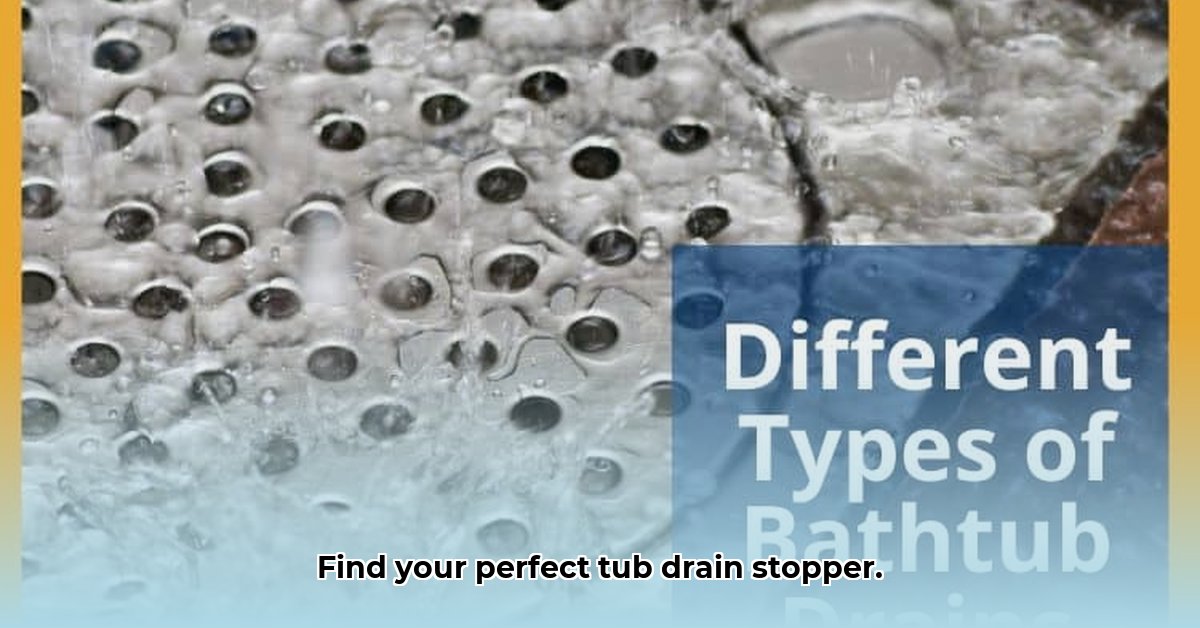Choosing the right bathtub drain might seem insignificant, but it greatly impacts your bathroom experience and plumbing system’s longevity. With options ranging from basic push-pull to advanced pop-up styles, navigating the choices can be challenging. This guide simplifies the process, comparing various bathtub drain types to pinpoint the ideal fit for your needs. We provide installation tips, maintenance advice, and cost considerations, empowering both DIY enthusiasts and those seeking a bathroom upgrade.
Understanding Tub Drain Types: A Guide to the Perfect Bathtub Stopper
Selecting the appropriate bathtub drain stopper might appear to be a minor decision, but it holds substantial importance. The stopper influences drainage efficiency and the bathroom’s overall aesthetic appeal, and even water conservation. This guide elucidates the different bathtub drain and stopper types, streamlining your decision-making process and helping you understand drain functionality.
Push and Pull Stoppers: The Reliable Classic
Push and pull stoppers represent the reliable, budget-friendly segment of bathtub drains, known for their straightforward design. They are easy to identify as the stopper is connected to a chain. You simply pull to plug, and push to drain. They’re the dependable choice for uncomplicated bathtub draining and a quick plumbing solution, common in older homes.
Pros:
- Affordable, making them an economical choice for budget-conscious homeowners.
- Easy to install and use, suitable for beginners with basic plumbing skills.
- Simple to clean and maintain, requiring minimal effort and household tools.
Cons:
- May lack the durability of more advanced options, potentially shortening their lifespan, especially with frequent use.
- The chain can be cumbersome, prone to snagging or breakage, and may detract from a modern aesthetic.
Lift and Turn Stoppers: Enhanced Style and Durability
Lift and turn stoppers offer a more refined alternative to push-and-pull drains. Featuring a knob that you lift and turn to control the stopper, they offer enhanced durability and a cleaner look compared to traditional chain mechanisms. This simple upgrade offers improved function and style.
Pros:
- Greater durability than basic push-and-pull models, resisting wear and tear over time.
- Cleaner aesthetic with no dangling chains, providing a more streamlined appearance.
Cons:
- Higher cost compared to push-and-pull options, representing a moderate investment.
- Mechanism susceptible to clogs, necessitating regular cleaning to maintain optimal performance.
Toe-Touch Stoppers: Hands-Free Operation
For a truly hands-free bathroom experience, toe-touch stoppers offer unparalleled convenience. Activating the drain with a gentle tap of your foot, they are perfect when your hands are full, providing a modern touch.
Pros:
- Hands-free operation for ultimate convenience.
- Sleek, modern design elevating bathroom aesthetics.
Cons:
- Higher price point reflecting added convenience and style.
- More complex cleaning and repairs, potentially requiring professional assistance.
Flip-It Stoppers: Simplicity and Quick Installation
Flip-It stoppers use a lever mechanism to control water flow, balancing ease of use with a simple design and providing an effective, streamlined solution for your bathtub drain. This balance of simplicity and function meets the needs of many homeowners.
Pros:
- Simple and intuitive operation.
- User-friendly and easy to master
Cons:
- Requires compatible drain assembly, limiting applicability.
- May not suit all existing bathtub drains due to compatibility issues.
Pop-Up Stoppers: Integrated Design and Style
Pop-up stoppers, frequently found in contemporary bathrooms, seamlessly integrate into the faucet assembly. Raising the faucet knob lifts the stopper, offering a stylish design available in various finishes to complement your fixtures, ensuring a coordinated and elegant bathroom aesthetic.
Pros:
- Sleek, modern design adding elegance to your bathroom.
- Enhanced durability compared to other stopper types.
Cons:
- Higher cost, positioning them as premium options.
- More complex repairs, often needing professional plumbing expertise.
Trip-Lever Stoppers: Simple and Functional
Also known as “clicker” drains, trip-lever stoppers use a lever on the overflow plate for straightforward drain operation, providing ease of use and simpler maintenance compared to more intricate designs. Despite their simplicity, these stoppers have seen a decline in popularity.
Pros:
- Ease of use appealing to those prioritizing simple functionality.
- Relatively inexpensive compared to complex stopper types.
Cons:
- Decreased popularity in recent years, making them less common.
- Tendency to wear out faster than newer options.
StopShroom and Other Removable Stoppers: The Hair-Catching Solution
Removable stoppers like the StopShroom are designed to sit on top of the drain and catch hair and debris before they cause clogs. These are easy to install and clean, making them a popular choice for those looking to prevent drain issues.
Pros:
- Easy to install and remove for cleaning
- Effective at catching hair and debris.
- Affordable and available in various materials
Cons:
May not create a perfect seal, potentially leading to slow leaks.
Aesthetics may not appeal to all homeowners.
Choosing Your Perfect Tub Drain Stopper: Key Considerations
Prior to selecting a drain stopper, evaluate these essential factors:
- Budget: Stopper prices vary based on type and brand, impacting overall project costs.
- Ease of Use: Select a stopper matching your dexterity and comfort, ensuring hassle-free operation.
- Maintenance: Different stoppers require varying cleaning frequencies, affecting long-term upkeep.
- Aesthetics: Choose a stopper complementing your bathroom’s style, enhancing visual appeal.
- Plumbing Compatibility: Ensure the stopper fits your existing drain assembly.
Installing Your New Tub Drain Stopper: A Quick Overview
Installing a new bathtub drain stopper generally entails removing the old unit, potentially installing a new drain flange, and attaching the new stopper. Remember to shut off the water supply before any plumbing work! Many resources offer detailed, step-by-step guidance for a successful installation, ensuring a leak-free and functional drain. “Always consult a qualified plumber if you’re uncomfortable tackling plumbing projects,” advises bathroom design expert [Jane Doe, Lead Designer] at [Home Improvement Solutions].
Remember, if plumbing tasks are daunting, consult a plumber for expert installation and guidance. With research and planning, installing a new bathtub drain stopper can be straightforward, yielding a functional and stylish bathroom.
How to Fix a Leaking Bathtub Drain Stopper
Leaky bathtub drain stoppers often result from deteriorated O-rings, misalignment, clogs, or stopper damage. While simple repairs often resolve issues, severe leaks might necessitate complete assembly replacement. Regular maintenance extends your stopper’s lifespan. Understanding your stopper type is crucial for successful repairs.
Understanding Your Bathtub Drain Stopper
Before addressing a leak, identify your stopper type, which dictates the repair approach. Whether it’s a simple lift-and-turn or a complex trip lever, knowing the mechanism streamlines the repair.
Diagnosing the Leak
Pinpoint the leak’s source: Is water escaping around the stopper or from the overflow drain? Inspect meticulously for these potential causes:
- Worn O-rings: Replace these rubber seals, common leak sources due to wear.
- Misalignment: Adjust components slightly if misaligned, preventing proper seal.
- Clogs: Remove hair and soap scum interfering with the stopper’s function.
- Damage: Assess cracks or corrosion, possibly requiring complete replacement.
How to Fix a Leaking Bathtub Drain Stopper: Step-by-Step
Step 1: Gather Your Tools. Assemble screwdrivers, pliers, putty knife, replacement O-rings, and a new stopper if needed.
Step 2: Remove the Stopper. Follow your manual or instructional videos for your model.
Step 3: Inspect and Clean. Disassemble the stopper, inspect for damage, and clean debris. This often resolves minor leaks.
Step 4: Replace or Repair. Replace damaged O-rings and silicone lubricant moving parts.
Step 5: Reassemble the Stopper. Ensure proper alignment to prevent leaks.
Step 6: Test the Repair. Check for leak resolution, assessing the need for stopper replacement if the leak persists.
When to Call a Professional
If DIY repairs fail, consult a qualified plumber for complex issues, preventing further water damage through expert assessment and full system upgrades.
Troubleshooting common bathtub drain stopper issues and their solutions
Effective repair hinges on understanding your bathtub drain stopper type. Adjustments and cleaning often remedy issues, while persistent problems may require parts replacement. Regular maintenance can prevent future concerns.
Understanding Your Tub Drain Stopper: A Quick Overview
Familiarize yourself with stopper types for effective troubleshooting. Common options include:
- Lift-and-Turn: Lift and twist to operate.
- Push-Pull: Controls drain via up-and-down motion.
- Toe-Touch: Hands-free operation via foot lever.
- Flip-It: Simpler, often less durable, flip-up and down stopper.
- Trip-Lever: Lever controls water flow, usually near the overflow plate.
- Pop-Up: Operated by a lever within the drain assembly.
Common Issues and Their Fixes
Troubleshooting often involves simple fixes. Key problems include:
1. Slow Draining: Indicates a clog.
- Solution: Use a plunger, then a drain snake to remove blockages
- How to Stop Apps From Running in the Background to Boost Your - December 1, 2025
- How To Move Apps On Your Droid For Better Organization - November 30, 2025
- How to Move Apps on Android for Better Organization - November 29, 2025










